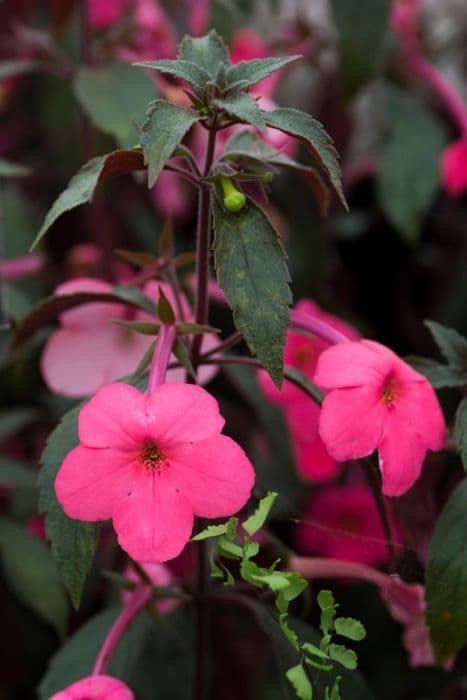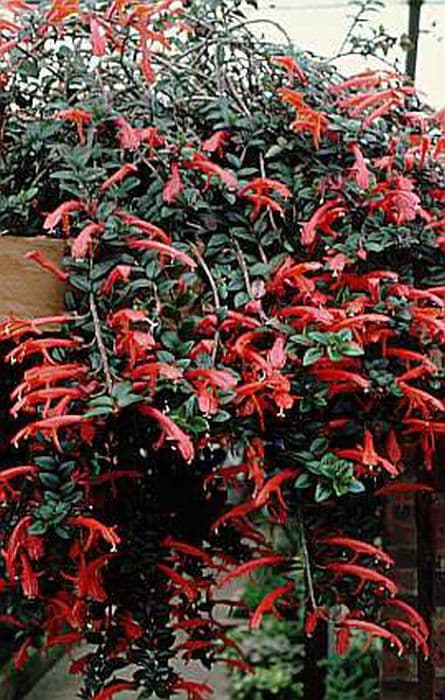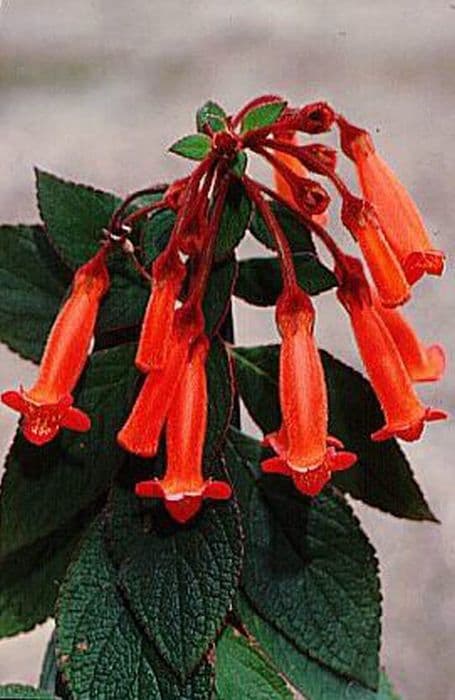Cape Primrose Streptocarpus 'Paula'

ABOUT
Streptocarpus 'Paula', known commonly as Cape Primrose, has a notable appearance characterized by rosettes of lush, green leaves that are long, slender, and softly textured. Its foliage serves as a backdrop to the stunning flowers that emerge on slender stalks. These blooms tend to be trumpet-shaped with a velvety texture, showcasing shades of purple and blue with intricate yellow and white throats, adding a striking contrast. The flowers are known for their ability to last a long time, often gracing the plant with continual blossoms if in the right conditions. The overall presentation of the Cape Primrose is one of delicate beauty and softly blended colors, making it a popular choice for indoor displays.
About this plant
 Names
NamesFamily
Gesneriaceae
Synonyms
Cape Primrose, African Violet Cousin, False African Violet, Twisted Seed Pod Plant
Common names
Streptocarpus 'Paula'.
 Toxicity
ToxicityTo humans
The Cape primrose (Streptocarpus 'Paula') is generally considered non-toxic to humans. Ingesting parts of the plant should not cause poisoning or serious health consequences; however, it is always wise to keep plants out of the reach of children, as individual reactions can vary, and it is not intended for consumption.
To pets
The Cape primrose (Streptocarpus 'Paula') is also generally considered non-toxic to pets, such as cats and dogs. It is not known to cause serious poisoning or health issues if consumed by pets. However, pet owners should still prevent pets from eating plants, as ingestion of non-food items can sometimes lead to gastrointestinal discomfort or other mild reactions.
 Characteristics
CharacteristicsLife cycle
Perennials
Foliage type
Evergreen
Color of leaves
Green
Flower color
Varies
Height
1 foot (30 cm)
Spread
1 foot (30 cm)
Plant type
Herb
Hardiness zones
10
Native area
South Africa
Benefits
 General Benefits
General Benefits- Easy to care for - Streptocarpus 'Paula' is known for being low-maintenance and easy to grow, making it suitable for beginner gardeners.
- Long blooming period - Cape Primrose offers a long flowering season, often blooming for several months with proper care.
- Variety of colors - It comes in a range of colors, adding vibrancy and diversity to indoor spaces.
- Compact size - Its small size makes it ideal for windowsills, desks, and small spaces.
- Decorative leaves - The plant has attractive foliage that provides visual interest even when it's not in bloom.
- Hybrid vigor - Being a hybrid, 'Paula' often exhibits greater resilience and more abundant blooms than some pure species.
 Medical Properties
Medical PropertiesThis plant is not used for medical purposes.
 Air-purifying Qualities
Air-purifying QualitiesThis plant is not specifically known for air purifying qualities.
 Other Uses
Other Uses- Artistic Inspiration: The plant's vibrant colors and velvety texture can inspire artists and can be used as a subject in paintings, drawings, or photography.
- Educational Tool: Educators can use the Cape Primrose to teach students about botany, hybridization, and plant care.
- Humidity Indicator: Cape Primrose prefers a consistent level of humidity, which makes it a natural indicator for the need to adjust indoor humidity levels.
- Sleep Aid: Placing a Cape Primrose in the bedroom may create a calming environment, potentially aiding in better sleep due to its soothing appearance.
- Ice Cream Garnish: The flowers of Cape Primrose can be crystallized and used as an edible decoration on desserts.
- Photography Prop: The unique look of Cape Primrose can serve as an attractive prop in product or fashion photography.
- Color Scheme Inspiration: Interior designers can take inspiration from the plant's color palette for room decor or textile design.
- Handmade Paper: Dried Cape Primrose petals can be incorporated into papermaking to create textured, decorative papers.
- Wedding Bouquets: Although not traditional, Cape Primrose can add a touch of originality and exotic flair to bridal arrangements or centerpieces.
- Fish Tank Enhancements: While not an aquatic plant, it can inspire colors and shapes for decorative elements in fish tanks.
Interesting Facts
 Feng Shui
Feng ShuiThe Cape Primrose is not used in Feng Shui practice.
 Zodiac Sign Compitability
Zodiac Sign CompitabilityThe Cape Primrose is not used in astrology practice.
 Plant Symbolism
Plant Symbolism- Persistence: Streptocarpus, also known as Cape Primrose, can bloom continuously throughout the year with proper care, symbolizing persistence and endurance.
- Hope and Renewal: The plant's ability to bloom in a variety of conditions is often associated with hope and the concept of overcoming challenges.
- Optimism: Cape Primrose's bright and cheerful flowers bring a sense of optimism and positivity to any environment.
 Water
WaterCape Primrose should be watered when the top inch of soil feels dry to the touch, which typically means once a week, but this can vary with environmental conditions. It's preferable to use room temperature water and to water the plant thoroughly until excess water drains out of the bottom of the pot, without letting the plant sit in standing water. Depending on the size of the pot and the humidity of the environment, you might use about one quart of water every week, adjusting as necessary for the plant's health and the ambient moisture.
 Light
LightCape Primrose thrives in bright, indirect light away from direct sunlight, which can scorch its leaves. An ideal spot would be near an east- or north-facing window, or a few feet away from a south- or west-facing window provided with a sheer curtain to diffuse the light.
 Temperature
TemperatureCape Primrose prefers moderate temperatures ranging from 60 to 75 degrees Fahrenheit. It should be protected from temperatures below 50 degrees Fahrenheit to avoid cold damage. The ideal temperature conditions for robust growth would be in the mid-60s to low 70s Fahrenheit range.
 Pruning
PruningCape Primrose should be pruned to remove any dead or yellowing leaves and spent flowers to encourage new growth and a more compact, healthy plant. Pruning is best done after flowering, typically in spring or summer. It's not necessary to prune the plant very often.
 Cleaning
CleaningAs needed
 Soil
SoilThe best soil mix for Cape Primrose is a light, well-draining mix with perlite, peat moss, and loam. The ideal soil pH for Cape Primrose should be slightly acidic to neutral, around 5.8 to 6.5.
 Repotting
RepottingCape Primrose should be repotted every year or when it outgrows its pot, which is typically seen when roots start to crowd.
 Humidity & Misting
Humidity & MistingCape Primrose thrives in moderate to high humidity levels, ideally between 50% and 70%.
 Suitable locations
Suitable locationsIndoor
Keep in bright, indirect light with high humidity.
Outdoor
Shelter from direct sun, protect from frost, high humidity.
Hardiness zone
10-11 USDA
 Life cycle
Life cycleThe life of a Cape Primrose (Streptocarpus 'Paula') begins with germination from seed, which generally requires warm temperatures and constant moisture. After the seedlings develop true leaves, they enter the vegetative growth stage, where they focus on producing a rosette of leaves, relying on adequate light but not direct sunlight, and regular watering to maintain moist soil. As the plant matures, it enters the flowering stage, typically in spring or summer, producing vibrant, trumpet-shaped flowers that can bloom for several months with proper care. After blooming, if pollinated, the Cape Primrose may produce seed pods, completing the reproduction cycle. Throughout its life, it will continually produce new leaves from the base, with older leaves eventually yellowing and dying off, requiring regular removal to encourage healthy growth. The plant can also be propagated asexually from leaf cuttings, which will root and grow into new plants, effectively extending the life cycle beyond the individual.
 Propogation
PropogationPropogation time
Late winter-early spring
Streptocarpus 'Paula', commonly known as Cape Primrose, is typically propagated through leaf cuttings. The ideal time for propagation is spring or early summer when the plant is actively growing. To propagate, a healthy, mature leaf is selected and cut across the width into sections, each containing a vein. The sections are then placed in a moist, well-draining potting mix, ensuring the cut edge is slightly buried. The pot is kept in a warm place with bright, indirect light and the soil is maintained slightly moist. Roots usually develop at the vein cuts, and new plantlets will emerge, which can later be separated and repotted once they have grown sufficiently. This method is simple and effective, making it the most popular for propagating Cape Primrose.









